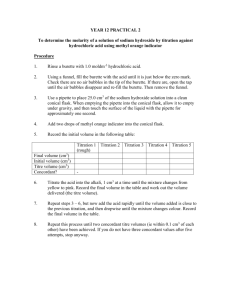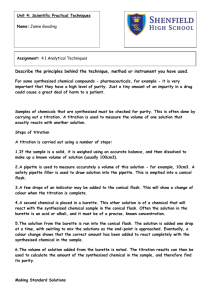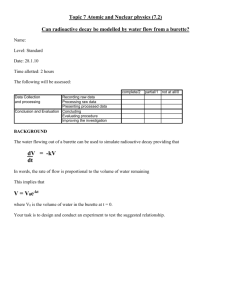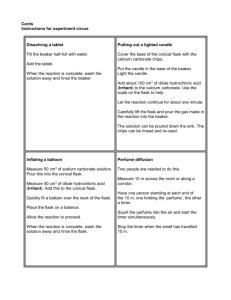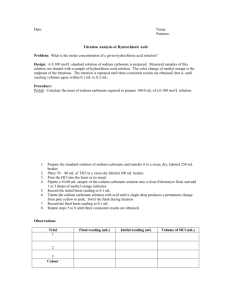Background
advertisement
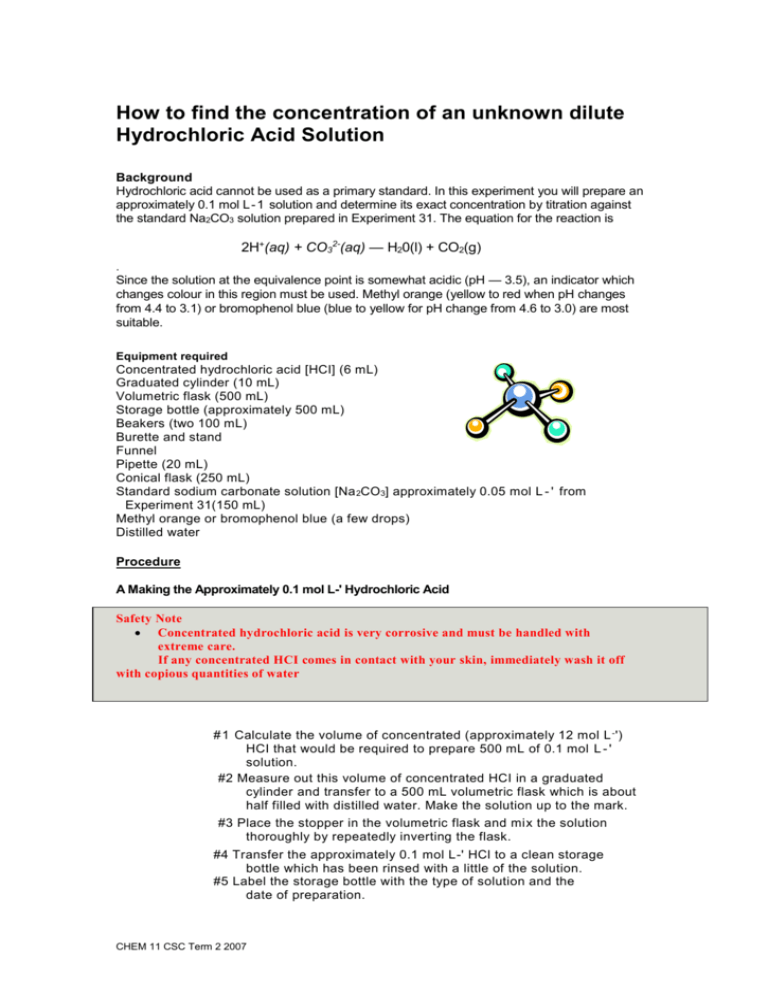
How to find the concentration of an unknown dilute Hydrochloric Acid Solution Background Hydrochloric acid cannot be used as a primary standard. In this experiment you will prepare an approximately 0.1 mol L - 1 solution and determine its exact concentration by titration against the standard Na2CO3 solution prepared in Experiment 31. The equation for the reaction is 2H+(aq) + CO32-(aq) — H20(l) + CO2(g) . Since the solution at the equivalence point is somewhat acidic (pH — 3.5), an indicator which changes colour in this region must be used. Methyl orange (yellow to red when pH changes from 4.4 to 3.1) or bromophenol blue (blue to yellow for pH change from 4.6 to 3.0) are most suitable. Equipment required Concentrated hydrochloric acid [HCI] (6 mL) Graduated cylinder (10 mL) Volumetric flask (500 mL) Storage bottle (approximately 500 mL) Beakers (two 100 mL) Burette and stand Funnel Pipette (20 mL) Conical flask (250 mL) Standard sodium carbonate solution [Na 2CO3] approximately 0.05 mol L - ' from Experiment 31(150 mL) Methyl orange or bromophenol blue (a few drops) Distilled water Procedure A Making the Approximately 0.1 mol L-' Hydrochloric Acid Safety Note Concentrated hydrochloric acid is very corrosive and must be handled with extreme care. If any concentrated HCI comes in contact with your skin, immediately wash it off with copious quantities of water # 1 Calculate the volume of concentrated (approximately 12 mol L - ') HCI that would be required to prepare 500 mL of 0.1 mol L - ' solution. #2 Measure out this volume of concentrated HCI in a graduated cylinder and transfer to a 500 mL volumetric flask which is about half filled with distilled water. Make the solution up to the mark. #3 Place the stopper in the volumetric flask and mix the solution thoroughly by repeatedly inverting the flask. #4 Transfer the approximately 0.1 mol L-' HCl to a clean storage bottle which has been rinsed with a little of the solution. #5 Label the storage bottle with the type of solution and the date of preparation. CHEM 11 CSC Term 2 2007 B Standardisation of the Hydrochloric Acid Solution Place about 100 mL of the standard Na 2 CO 3 solution into a clean beaker. If the beaker is wet, rinse with a little of the solution first. Rinse a clean 20 mL pipette with some of the Na 2 CO 3 solution. Pipette 20 mL of the Na 2 CO3 solution into a 250 mL conical flask. Add 2-3 drops of your chosen indicator to the flask. Place about 100 mL of HCI into a clean beaker. Again, if necessary, rinse the beaker with a little of the solution first. Rinse a clean burette with some of the HCI and then fill the burette with the solution. Note and record the level of acid in the burette. Obtain a rough estimate of the titration volume by running acid quickly from the burette while constantly swirling the liquid in the conical flask. Cease delivery of the acid as soon as a permanent colour change is obtained. Note and record the acid level in the burette and deduce the approximate volume of acid required. #6 Record your results in a table similar to the one shown below Rough estimate Final reading (mL) Accurate titrations 1 2 3 - Initial reading (mL) Titration volume (mL) 7 Prepare another conical flask containing 20 mL of the Na 2CO3 solution and 2-3 drops of indicator. This time add the acid quickly from the burette with constant swirling of the flask, until the volume added is within 2 -3 mL of the approximate volume required. Rinse the inside of the conical flask with a jet of water from a CHEM 11 CSC Term 2 2007 wash bottle to return any splashed solution to the bulk. Continue adding acid drop by drop, and with constant swirling, until the addition of one drop is sufficient to produce a permanent colour change. Note and record the level of the acid in the burette at the end point. #8 Repeat the accurate titration with further 20 mL portions of Na 2 CO3 solution until consistent titration volumes are obtained. Processing of results, and questions 1 Write the equation for the reaction. 2 Calculate the number of moles of Na2 CO3 used in each titration . 3 From the equation determine the number of moles of HCI which reacts with each mole of Na2 CO3 . Use this to determine the number of moles of HCI used in the titration. 4 Calculate the average volume of HCI used in the titrations. Use only those results which are reasonably consistent. From this determine the concentration of the HCI. Mark this information on the label of the storage bottle. 5 Distinguish between the 'equivalence point' of a reaction and the 'end point' of a titration. 6 In the Background it was stated that the solution at the equivalence point is 'somewhat acidic'. Explain why this is so. 7 Suppose that phenolphthalein, whose colour change is in the vicinity of pH 9, had been used instead of one of the indicators recommended. a Would the volume of acid required for the titration be more or less than that obtained? b Would the calculated concentration of the HCI be higher or lower than the result obtained? CHEM 11 CSC Term 2 2007 I

